Design and Simulation of a Wireless SAW–Pirani Sensor with Extended Range and Sensitivity
Abstract
1. Introduction
2. Theoretical Background
- Solid conduction from the Pirani sensor to its carrier; the value of the thermal conductance depends on the geometry of the sensor’s carrier and its thermal conductivity.
- Radiation from the sensor’s hot surface to the surface of the chamber; its value depends on the emissivity and the exterior surface of the sensor.
- Solid to gas conduction from the sensor to the gas molecules that contact it, which effectively depends on pressure.
3. Sensor Description
3.1. Structure of the Sensor
3.2. Components of the Sensor
- A polymer housing crossed by the microchannel;
- A SAW–Pirani chip consisting of a block of lithium niobate with an interdigital transducer printed at its surface and a Joule resistance layer at its bottom;
- A heating coil encapsulated by liquid polymer which acts as a seal and controls the temperature;
- An interrogation antenna made with silver screen printing.
3.3. Operation of the Sensor
3.4. Sensor Simulation
4. Discussion
4.1. Thermal Analysis
- For , a continuum flow is taking place and is accurately modeled by the compressible Navier–Stokes equations with classical no-slip boundary conditions.
- For , the flow is a slip flow and the Navier–Stokes equations remain applicable, provided a velocity slip and a temperature jump are taken into account at the walls. Rarefaction effects become sensitive at the walls first.
- For , the flow is a transition flow. The intermolecular collisions are not yet negligible and have to be taken into account.
- For , the flow is a free molecular flow and the occurrence of intermolecular collisions is negligible compared to the collisions of the gas molecules with the walls.
4.2. Wireless Transmission Methods
4.3. Choice of the Interrogation Frequency and Interrogation Antenna
5. Conclusions
Author Contributions
Funding
Conflicts of Interest
References
- Figliola, R.S.; Beasley, D.E. Theory and design for mechanical measurements. Meas. Sci. Technol. 1996, 12, 1743. [Google Scholar] [CrossRef]
- Pace, E.L. Scientific foundations of vacuum technique (Dushman, Saul). J. Chem. Educ. 1962, 39, A606. [Google Scholar] [CrossRef]
- Völklein, F.; Grau, M.; Meier, A.; Hemer, G.; Breuer, L.; Woias, P. Optimized MEMS Pirani sensor with increased pressure measurement sensitivity in the fine and high vacuum regime. J. Vac. Sci. Technol. A Vac. Surf. Film. 2013, 31, 061604. [Google Scholar] [CrossRef]
- Jitschin, W.; Ludwig, S. Dynamical behaviour of the Pirani sensor. Vacuum 2004, 75, 169–176. [Google Scholar] [CrossRef]
- Weng, P.K.; Shie, J.S. Micro-Pirani vacuum gauge. Rev. Sci. Instrum. 1994, 65, 492–499. [Google Scholar] [CrossRef]
- Grau, M.; Völklein, F.; Meier, A.; Kunz, C.; Kaufmann, I.; Woias, P. Optimized MEMS Pirani sensor with increased pressure measurement sensitivity in the fine and rough vacuum regimes. J. Vac. Sci. Technol. A Vac. Surf. Film. 2014, 33, 021601. [Google Scholar] [CrossRef]
- Xiao, B.; Dong, T.; Halvorsen, E.; Yang, Z.; Zhang, Y.; Hoivik, N.; Gu, D.; Tran, N.M.; Jakobsen, H. Integrated micro Pirani gauge based hermetical package monitoring for uncooled VOxbolometer FPAs. Microsyst. Technol. 2011, 17, 115–125. [Google Scholar] [CrossRef]
- Völklein, F.; Meier, A. Microstructured vacuum gauges and their future perspectives. Vacuum 2007, 82, 420–430. [Google Scholar] [CrossRef]
- Van Herwaarden, A.W.; Sarro, P.M. Performance of integrated thermopile vacuum sensors. J. Phys. E Sci. Instrum. 1988, 21, 1162–1167. [Google Scholar] [CrossRef]
- Völklein, F.; Schnelle, W. A vacuum microsensor for the low-vacuum range. Sens. Mater. 1991, 3, 41–48. [Google Scholar]
- Piotto, M.; Del Cesta, S.; Bruschi, P. A Compact CMOS Compatible micro-Pirani Vacuum Sensor with Wide Operating Range and Low Power Consumption. Procedia Eng. 2016, 168, 766–769. [Google Scholar] [CrossRef]
- Mastrangelo, C.H.; Muller, R.S. Microfabricated thermal absolute-pressure sensor with on-chip digital front-end processor. IEEE J. Solid-State Circuits 1991, 26, 1998–2007. [Google Scholar] [CrossRef]
- Swart, N.R.; Nathan, A. An integrated CMOS polysilicon coil-based micro-Pirani gauge with high heat transfer efficiency. In Proceedings of the 1994 IEEE International Electron Devices Meeting, San Francisco, CA, USA, 11–14 December 1994; pp. 135–138. [Google Scholar]
- Chae, J.; Stark, B.H.; Najafi, K. A micromachined Pirani gauge with dual heat sinks. In Proceedings of the 17th IEEE International Conference on Micro Electro Mechanical Systems. Maastricht MEMS 2004 Technical Digest, Maastricht, The Netherlands, 25–29 January 2004; pp. 532–535. [Google Scholar]
- Moelders, N.; Daly, J.T.; Greenwald, A.C.; Johnson, E.A.; McNeal, M.P.; Patel, R.; Pralle, M.U.; Puscasu, I. Micro and Nanosystems Symposium, Boston 2004; Society, M.R., Ed.; MRS: Boston, MA, USA, 2004; p. 211. [Google Scholar]
- Doms, M.; Bekesch, A.; Mueller, J. A microfabricated Pirani pressure sensor operating near atmospheric pressure. J. Micromech. Microeng. 2005, 15, 1504–1510. [Google Scholar] [CrossRef]
- Stark, B.H.; Junseok, C.; Kuo, A.; Oliver, A.; Khalil, N. A high-performance surface-micromachined Pirani gauge in SUMMIT V/spl trade. In Proceedings of the 18th IEEE International Conference on Micro Electro Mechanical Systems, 2005. MEMS 2005, Miami Beach, FL, USA, 30 January–3 February 2005; pp. 295–298. [Google Scholar]
- Mitchell, J.; Lahiji, G.R.; Najafi, K. An Improved Performance Poly-Si Pirani Vacuum Gauge Using Heat-Distributing Structural Supports. J. Microelectromech. Syst. 2008, 17, 93–102. [Google Scholar] [CrossRef]
- Khosraviani, K.; Leung, A.M. The nanogap Pirani—A pressure sensor with superior linearity in an atmospheric pressure range. J. Micromech. Microeng. 2009, 19, 045007. [Google Scholar] [CrossRef]
- Li, Q.; Goosen, J.F.L.; van Beek, J.T.M.; van Keulen, F. A novel SOI Pirani sensor with triple heat sinks. Procedia Chem. 2009, 1, 160–163. [Google Scholar] [CrossRef]
- Jiang, W.; Wang, X.; Zhang, J. A single crystal silicon micro-Pirani vacuum gauge with high aspect ratio structure. Sens. Actuators A Phys. 2010, 163, 159–163. [Google Scholar] [CrossRef]
- Chen, C. Characterization of Gas Conductance of a Thermal Device with a V-Groove Cavity. IEEE Electron Device Lett. 2012, 33, 275–277. [Google Scholar] [CrossRef]
- Puers, R.; Reyntjens, S.; De Bruyker, D. The NanoPirani—An extremely miniaturized pressure sensor fabricated by focused ion beam rapid prototyping. Sens. Actuators A Phys. 2002, 97–98, 208–214. [Google Scholar] [CrossRef]
- Moutaouekkil, M.; Talbi, A.; Viard, R.; Gerbedoen, J.C.; Okada, E.; Elmazria, O.; Preobrazhensky, V.; Merlen, A.; Pernod, P.; Joint International Laboratory LIA LICS/LEMAC. Elaboration of a Novel Design Pirani Pressure Sensor for High Dynamic Range Operation and Fast Response Time. Procedia Eng. 2015, 120, 225–228. [Google Scholar] [CrossRef]
- Mailly, F.; Dumas, N.; Pous, N.; Latorre, L.; Garel, O.; Martincic, E.; Verjus, F.; Pellet, C.; Dufour-Gergam, E.; Nouet, P. Pirani pressure sensor for smart wafer-level packaging. Sens. Actuators A Phys. 2009, 156, 201–207. [Google Scholar] [CrossRef]
- Robinson, A.M.; Haswell, P.; Lawson, R.P.W.; Parameswaran, M. A thermal conductivity microstructural pressure sensor fabricated in standard complementary metal-oxide semiconductor. Rev. Sci. Instrum. 1992, 63, 2026–2029. [Google Scholar] [CrossRef]
- Paul, O.; Haberli, A.; Malcovati, P.; Baltes, H. Novel integrated thermal pressure gauge and read-out circuit by CMOS IC technology. In Proceedings of the 1994 IEEE International Electron Devices Meeting, San Francisco, CA, USA, 11–14 December 1994; pp. 131–134. [Google Scholar]
- Shie, J.S.; Chou, B.C.S.; Chen, Y.M. High performance Pirani vacuum gauge. J. Vac. Sci. Technol. A 1995, 13, 2972–2979. [Google Scholar] [CrossRef]
- Jong, B.R.D.; Bula, W.P.; Zalewski, D.; Baar, J.J.V.; Wiegerink, R.J. Pirani pressure sensor with distributed temperature measurement. In Proceedings of the SENSORS, 2003 IEEE, Toronto, ON, Canada, 22–24 October 2003; Volume 1, pp. 718–722. [Google Scholar]
- Zhang, F.T.; Tang, Z.; Yu, J.; Jin, R.C. A micro-Pirani vacuum gauge based on micro-hotplate technology. Sens. Actuators A Phys. 2006, 126, 300–305. [Google Scholar] [CrossRef]
- Takashima, N.; Kimura, M. Investigation on the Thin Film Pirani Vacuum Sensor Using A Constant Voltage Drive-Mode Diode-Heater. IEEJ Trans. Sens. Micromach. 2008, 128, 209–213. [Google Scholar] [CrossRef]
- Jeon, G.-J.; Kim, W.Y.; Shim, H.B.; Lee, H.C. Nanoporous Pirani sensor based on anodic aluminum oxide. Appl. Phys. Lett. 2016, 109, 123505. [Google Scholar] [CrossRef]
- Paul, O.; Baltes, H. Novel fully CMOS-compatible vacuum sensor. Sens. Actuators A Phys. 1995, 46, 143–146. [Google Scholar] [CrossRef]
- Wenzel, O.; Bak, C.K. The Micro Pirani™: A solid-state vacuum gauge with wide range. Vak. Forsch. Prax. 1998, 10, 298–301. [Google Scholar] [CrossRef]
- Qiu, Y.; Zhao, L.; Jin, Y. A novel micro pirani gauge with mono-wire sensing unit for microsystem application. In Proceedings of the 2009 International Conference on Electronic Packaging Technology & High Density Packaging, Beijing, China, 10–13 August 2009; pp. 467–470. [Google Scholar]
- Brun, T.; Mercier, D.; Koumela, A.; Marcoux, C.; Duraffourg, L. Silicon nanowire based Pirani sensor for vacuum measurements. Appl. Phys. Lett. 2012, 101, 183506. [Google Scholar] [CrossRef]
- Ghouila-Houri, C.; Sindjui, R.; Moutaouekkil, M.; Elmazria, O.; Gallas, Q.; Garnier, E.; Merlen, A.; Viard, R.; Talbi, A.; Pernod, P. Nanogap Pirani Sensor Operating in Constant Temperature Mode for Near Atmospheric Pressure Measurements. Proceedings 2017, 1, 377. [Google Scholar] [CrossRef]
- Schelcher, G.; Fabbri, F.; Lefeuvre, E.; Brault, S.; Coste, P.; Dufour-Gergam, E.; Parrain, F. Modeling and characterization of MicroPirani vacuum gauges manufactured by a low-temperature film transfer process. J. Microelectromech. Syst. 2011, 20, 1184–1191. [Google Scholar] [CrossRef]
- Wang, X.; Liu, C.; Zhang, Z.; Liu, S.; Luo, X. A micro-machined Pirani gauge for vacuum measurement of ultra-small sized vacuum packaging. Sens. Actuators A Phys. 2010, 161, 108–113. [Google Scholar] [CrossRef]
- Santagata, F.; Iervolino, E.; Mele, L.; van Herwaarden, A.W.; Creemer, J.F.; Sarro, P.M. An analytical model and verification for MEMS Pirani gauges. J. Micromech. Microeng. 2011, 21, 115007. [Google Scholar] [CrossRef]
- Mercier, D.; Bordel, G.; Brunet-Manquat, P.; Verrun, S.; Elmazria, O.; Sarry, F.; Belgacem, B.; Bounoua, J. Characterization of a SAW-Pirani vacuum sensor for two different operating modes. Sens. Actuators A Phys. 2012, 188, 41–47. [Google Scholar] [CrossRef]
- Rokhlin, S.I.; Kornblit, L.; Gorodetsky, G. Surface acoustic wave pressure transducers and accelerometers. Prog. Aerosp. Sci. 1984, 21, 1–31. [Google Scholar] [CrossRef]
- Singh, K.J.; Elmazria, O.; Sarry, F.; Nicolay, P.; Ghoumid, K.; Belgacem, B.; Mercier, D.; Bounouar, J. Enhanced Sensitivity of SAW-Based Pirani Vacuum Pressure Sensor. IEEE Sens. J. 2011, 11, 1458–1464. [Google Scholar] [CrossRef]
- Joshi, S.G. Use of a surface-acoustic-wave (SAW) device to measure gas flow. IEEE Trans. Instrum. Meas. 1989, 38, 824–826. [Google Scholar] [CrossRef]
- Nicolay, P. Surface Acoustic Wave sensors: Applications for the Measurement of Low Pressures and High Temperatures. Ph.D. Thesis, Université Henri Poincaré, Nancy, France, 2007. [Google Scholar]
- Nicolay, P.; Lenzhofer, M. A wireless and passive low-pressure sensor. Sensors 2014, 14, 3065–3076. [Google Scholar] [CrossRef]
- Fu, C.; Ke, Y.; Li, M.; Luo, J.; Li, H.; Liang, G.; Fan, P. Design and Implementation of 2.45 GHz Passive SAW Temperature Sensors with BPSK Coded RFID Configuration. Sensors 2017, 17, 1849. [Google Scholar] [CrossRef]
- Kandlikar, S.; Garimella, S.; Li, D.; Colin, S.; King, M.R. Heat Transfer and Fluid Flow in Minichannels and Microchannels; Elsevier Science: Oxford, UK, 2006. [Google Scholar]
- Royer, D.; Dieulesaint, E. Ondes Élastiques Dans les Solides; Masson: Paris, France, 1996; p. 321. [Google Scholar]
- Kalempa, D.; Sharipov, F. Numerical modelling of thermoacoustic waves in a rarefied gas confined between coaxial cylinders. Vacuum 2014, 109, 326–332. [Google Scholar] [CrossRef]
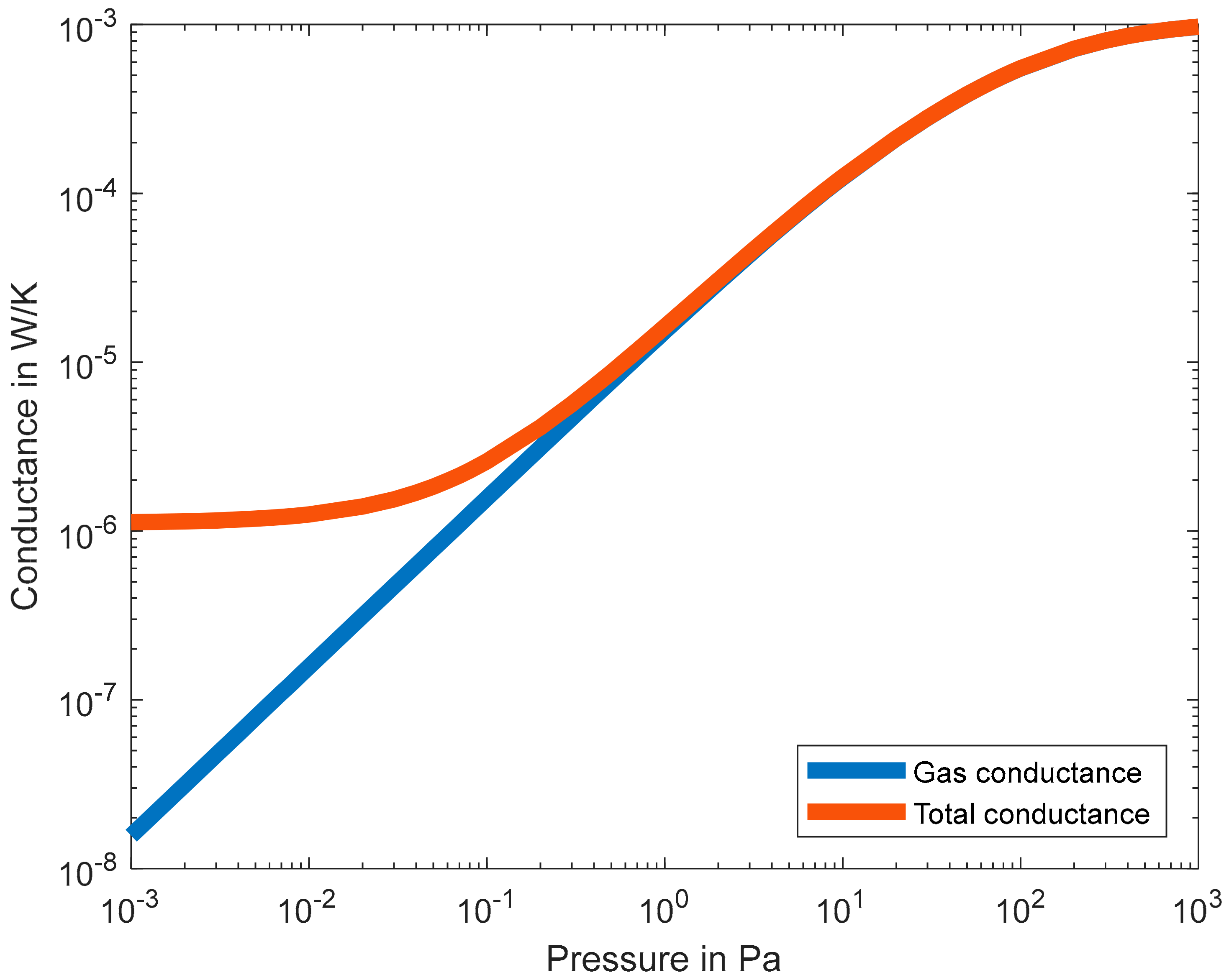
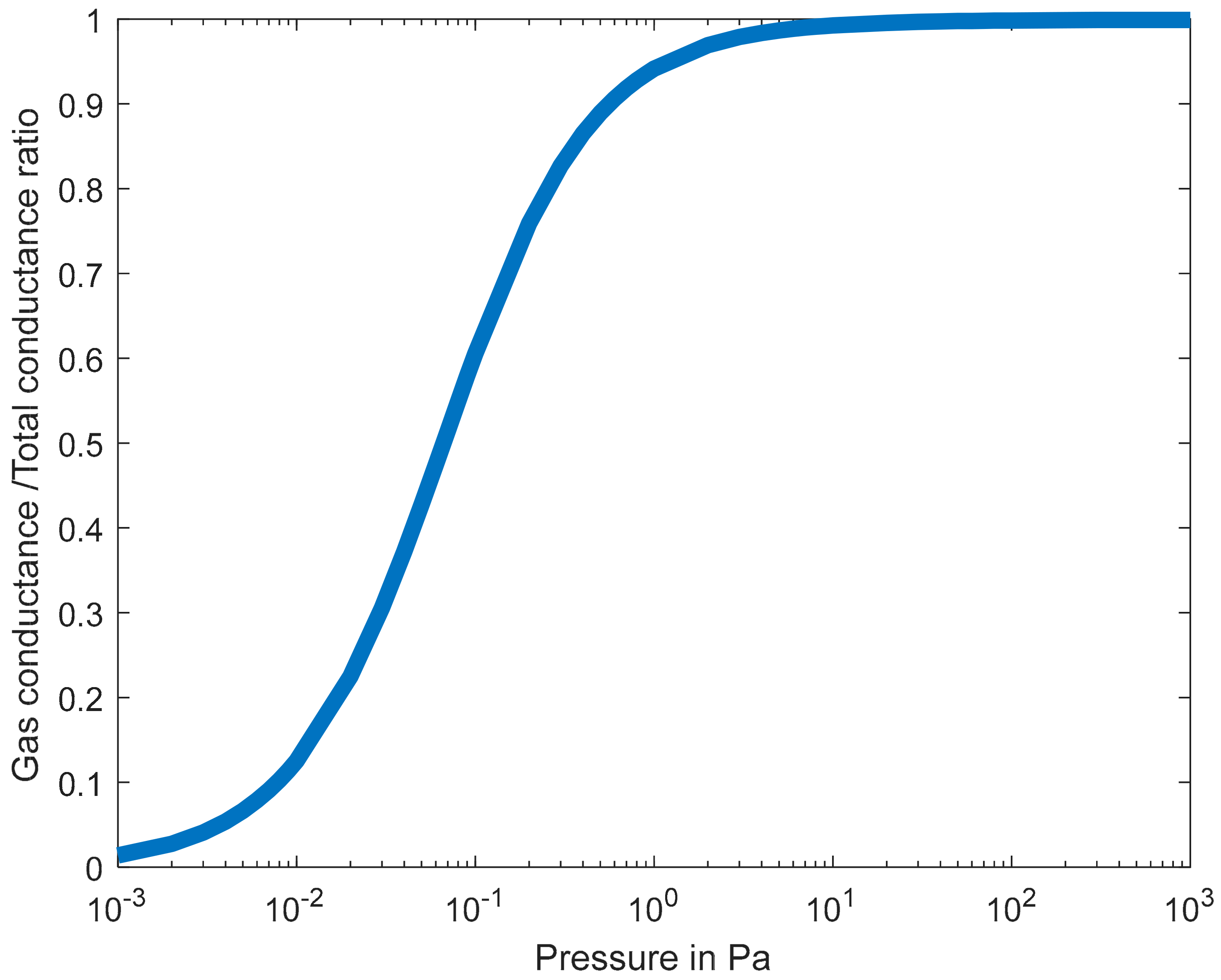

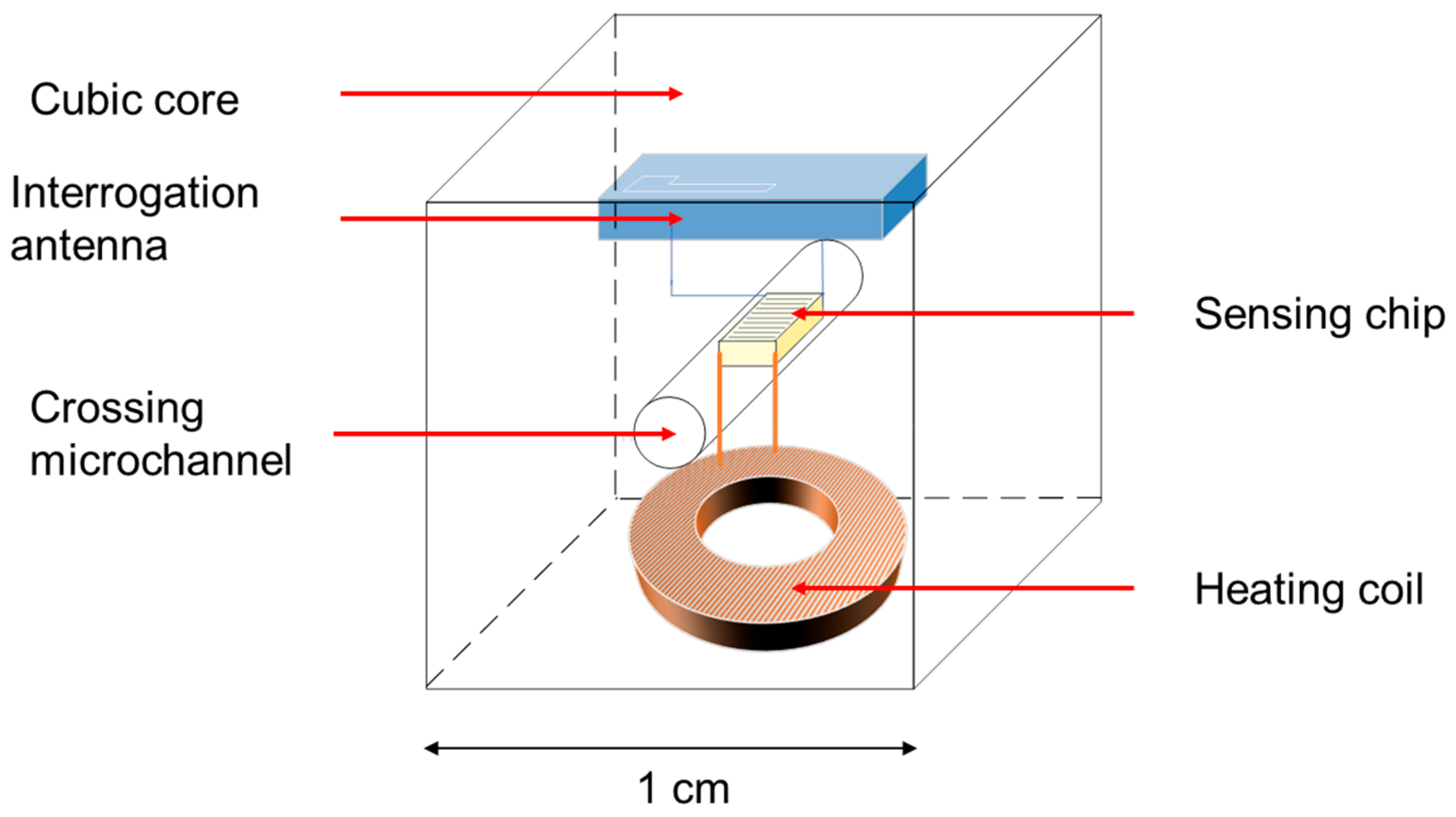



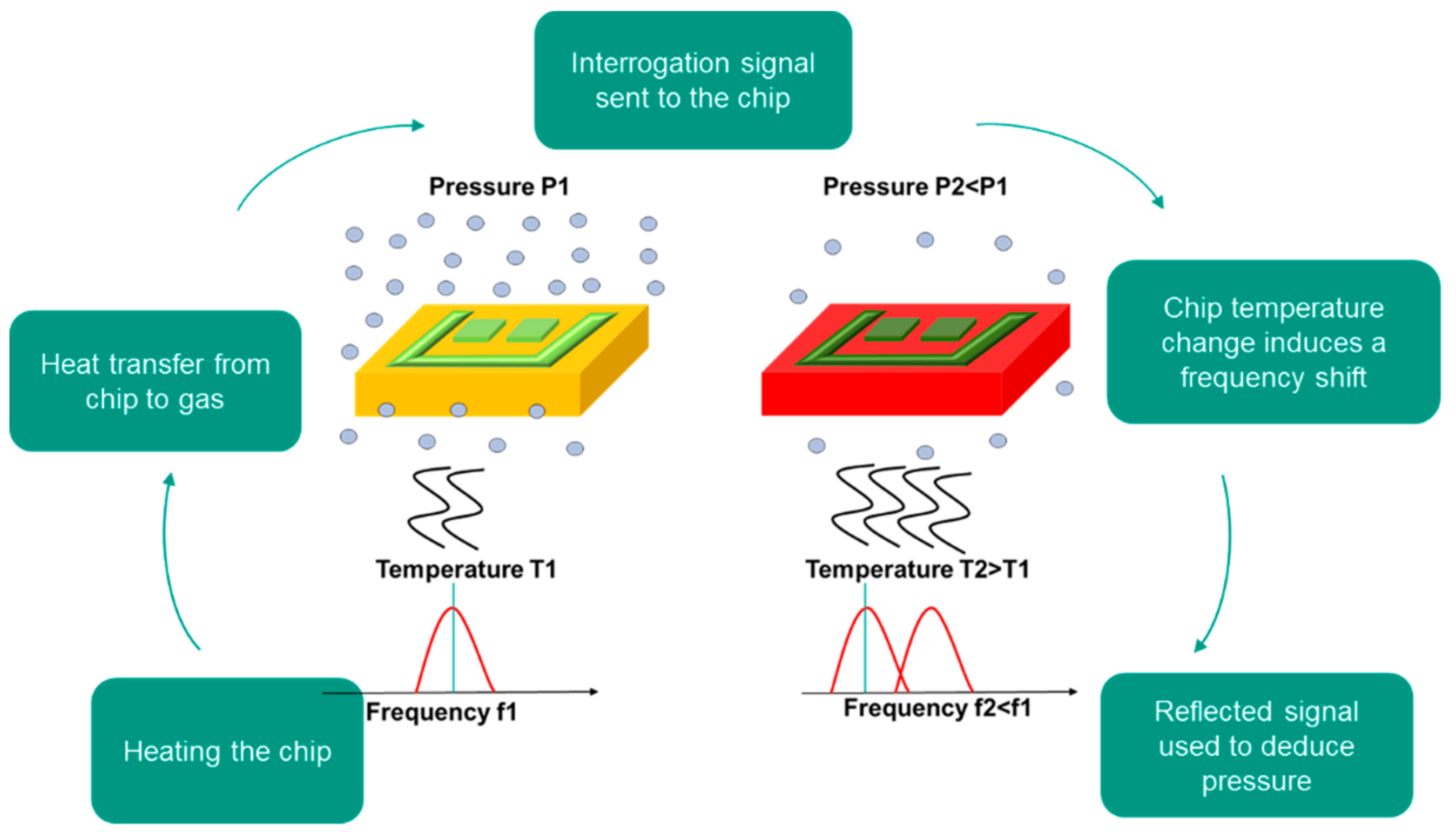
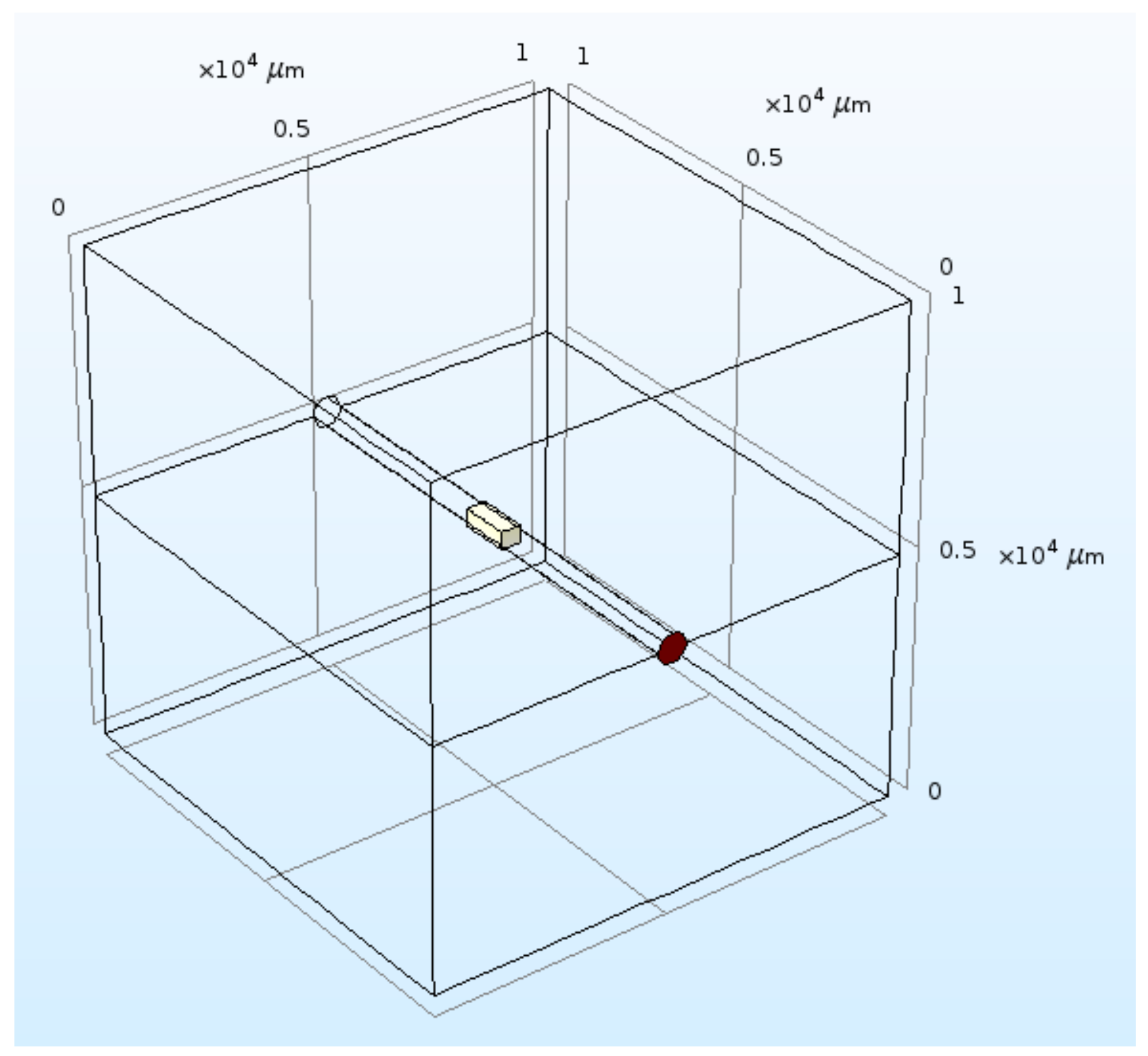

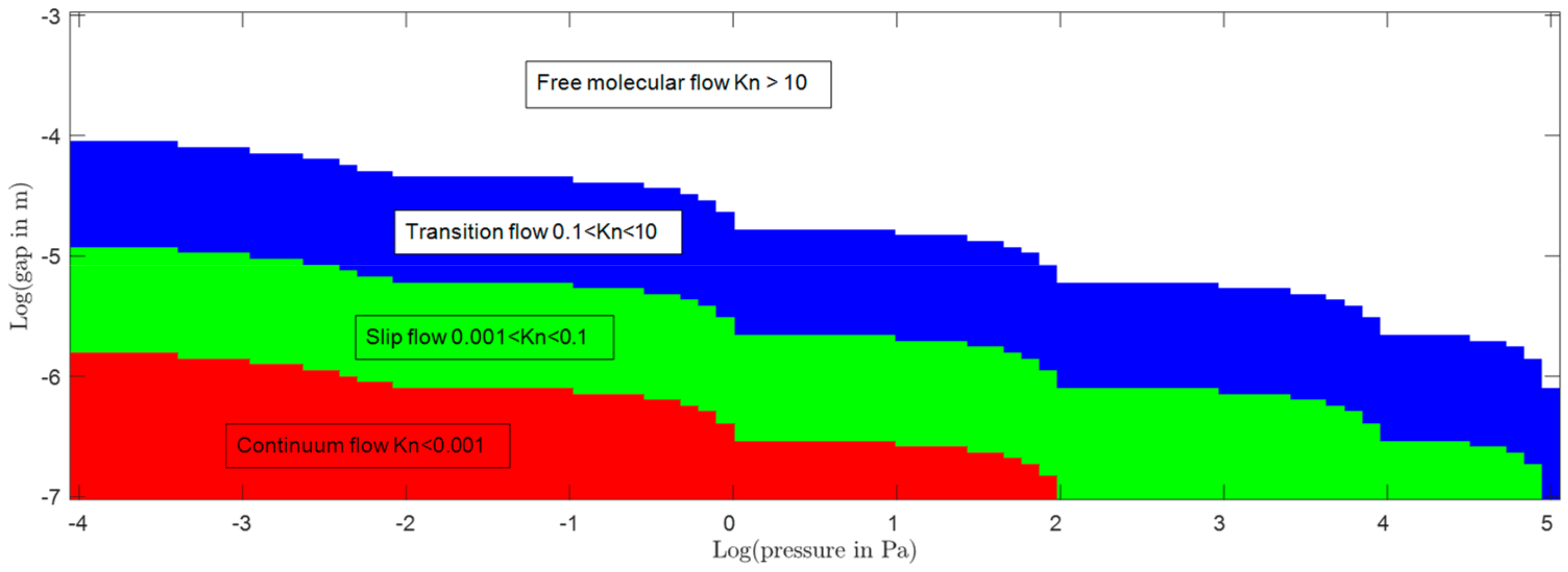
| Pressure Range in Pa | Degree of Vacuum |
|---|---|
| 105 to 3 × 103 | Low vacuum |
| 3 × 103 to 10−1 | Medium vacuum |
| 10−1 to 10−4 | High vacuum |
| 10−4 to 10−7 | Very high vacuum |
| 10−7 to 10−10 | Ultra-high vacuum (UHV) |
| <10−10 | Extreme-ultrahigh vacuum (EHV or XHV) |
| Researcher | Type of Gauge | Pressure Range (Pa) |
|---|---|---|
| Van Herwaarden and Sarro, 1988 [9] | Heated cantilever combined with thermopile | 0.13–13,300 |
| Völklein and Schnelle, 1991 [10] | Heated resistor combined with thermopile | 0.13–10 |
| Piotto et al., 2016 [11] | Heated resistor with thermopile | 0.3–105 |
| Mastrangelo and Muller, 1991 [12] | Microbridge | 10–10,000 |
| Swart et al., 1994 [13] | Microbridge | 13–1.33 × 105 |
| Chae et al., 2004 [14] | Microbridge | 2.6–267 |
| Moelders et al., 2004 [15] | Microbridge | 1.33–133 |
| Doms et al., 2005 [16] | Microbridge | 100–105 |
| Stark et al., 2005 [17] | Microbridge | 1.33–106 |
| Mitchell et al., 2008 [18] | Microbridge | 1.33–105 |
| Khosraviani and Leung, 2009 [19] | Microbridge | 13.3–106 |
| Li et al., 2009 [20] | Microbridge | 10.6–26,665 |
| Jiang et al., 2010 [21] | Microbridge | 0.1–1,000 |
| Chen, 2012 [22] | Microbridge | 133–1.33 × 105 |
| Puers et al., 2002 [23] | Microbridge | 100–107 |
| Moutaouekkil et al., 2015 [24] | Microbridge | 1,000–105 |
| Mailly et al., 2009 [25] | Microbridge | 20–20,000 |
| Robinson et al., 1992 [26] | Resistor on dielectric membrane | 10–13,300 |
| Paul et al., 1994 [27] | Resistor on dielectric membrane | 100–105 |
| Weng and Shie, 1994 [5] | Resistor on dielectric membrane | 1.33 × 10−5–133 |
| Shie et al., 1995 [28] | Resistor on dielectric membrane | 13.3–1.33 × 107 |
| De Jong et al., 2003 [29] | Resistor on dielectric membrane | 10–20,000 |
| Zhang et al., 2006 [30] | Resistor on dielectric membrane | 10–105 |
| Völklein et al., 2013 [3] | Resistor on dielectric membrane | 1.33 × 10−4–1332 |
| Grau et al., 2014 [6] | Resistor on dielectric membrane | 0.13–105 |
| Xiao et al., 2011 [7] | Resistor on dielectric membrane | 1–1,000 |
| Takashima et al., 2008 [31] | Resistor on dielectric membrane | 0.002–105 |
| Jeon et al., 2016 [32] | Resistor on dielectric membrane | 0.013–105 |
| Paul and Baltes, 1995 [33] | Resistor on dielectric membrane | 100–106 |
| Wenzel and Bak, 1998 [34] | Resistor on diaphragm | 10–105 |
| Qiu et al., 2009 [35] | Metallic wire | 1–100 |
| Brun et al., 2012 [36] | Silicon nanowire | 50–105 |
| Ghouila-Houri et al., 2017 [37] | Microwire | 10,000–8 × 105 |
| Schelcher et al., 2011 [38] | Ni-microbeam | 3.3–105 |
| Wang et al., 2010 [39] | Microplate | 0.1–105 |
| Santagata et al., 2011 [40] | Tube-shaped | 0.133–1.33 × 105 |
| Mercier et al., 2012 [41] | Cr/Au-resistor on LiNbO3-substrate (SAW device) | 0.001–105 |
| Pressure Range | Frequency Shift |
|---|---|
| 10−4 to 10−3 Pa | 15.435 kHz |
| 10−3 to 10−2 Pa | 152.145 kHz |
| 103 to 104 Pa | 55.125 kHz |
| 104 to 105 Pa | 6.615 kHz |
| Pressure | Mean Free Path | Minimum Size for Knudsen Number below 10 |
|---|---|---|
| 0.0001 Pa | 11.4435 m | 1.14 m |
| 0.001 Pa | 1.144 m | 0.114 m |
| 0.01 Pa | 0.1144 m | 0.01144 m |
| 0.1 Pa | 0.0114 m | 0.00114 m |
| 1 Pa | 0.0011 m | 0.00011 m |
| 10 Pa | 1.1444 × 10−4 m | 1.1444 × 10−5 m |
| 100 Pa | 1.1444 × 10−3 m | 1.1444 × 10−4 m |
| 1000 Pa | 1.178 µm | 117.8 nm |
| 10,000 Pa | 117.8 nm | 11.78 nm |
| 50,000 Pa | 23.6 nm | 2.36 nm |
| 100,000 Pa | 11.8 nm | 1.18 nm |
| 101,325 Pa | 11.6 nm | 1.16 nm |
| 200,000 Pa | 5.9 nm | 5.9 Å |
| Pressure | Thermal Conductivity (W/m/K) |
|---|---|
| High Vacuum | |
| 0.0001 Pa | 4.9 × 10−7 |
| 0.0002 Pa | 9.8 × 10−7 |
| 0.0003 Pa | 1.47 × 10−6 |
| 0.0005 Pa | 2.45 × 10−6 |
| 0.001 Pa | 4.90 × 10−6 |
| Near Atmospheric Pressure | |
| 1000 Pa | 0.0163 |
| 10,000 Pa | 0.0232 |
| 50,000 Pa | 0.0245 |
| 100,000 Pa | 0.0246 |
| 200,000 Pa | 0.0252 |
| Energy Coupling | Magnetic Induction | Magnetic Resonance | Electrostatic Coupling | Wireless Transmission |
|---|---|---|---|---|
| Description | Inductive coupling between 2 coils | Coupling between 2 tuned oscillating circuits | Capacitive coupling between 2 electrodes | Reception of radio waves and rectification |
| Distance | Few mm to 10 cm | Few cm to m | Few mm to few cm | Up to a few m |
| Transferable power | Few W to several kW | Few W to kW | Few W to few 100s of W | 1 W max |
| Electrical efficiency | 70% to 90% heat loss | 40% to 60% residual heat | 60% to 90% heat loss | |
| Frequency | 10 kHz | Few 100 kHz up to MHz | Few 100 kHz to few MHz | Frequencies up to microwaves |
© 2019 by the authors. Licensee MDPI, Basel, Switzerland. This article is an open access article distributed under the terms and conditions of the Creative Commons Attribution (CC BY) license (http://creativecommons.org/licenses/by/4.0/).
Share and Cite
Toto, S.; Nicolay, P.; Morini, G.L.; Rapp, M.; Korvink, J.G.; Brandner, J.J. Design and Simulation of a Wireless SAW–Pirani Sensor with Extended Range and Sensitivity. Sensors 2019, 19, 2421. https://doi.org/10.3390/s19102421
Toto S, Nicolay P, Morini GL, Rapp M, Korvink JG, Brandner JJ. Design and Simulation of a Wireless SAW–Pirani Sensor with Extended Range and Sensitivity. Sensors. 2019; 19(10):2421. https://doi.org/10.3390/s19102421
Chicago/Turabian StyleToto, Sofia, Pascal Nicolay, Gian Luca Morini, Michael Rapp, Jan G. Korvink, and Juergen J. Brandner. 2019. "Design and Simulation of a Wireless SAW–Pirani Sensor with Extended Range and Sensitivity" Sensors 19, no. 10: 2421. https://doi.org/10.3390/s19102421
APA StyleToto, S., Nicolay, P., Morini, G. L., Rapp, M., Korvink, J. G., & Brandner, J. J. (2019). Design and Simulation of a Wireless SAW–Pirani Sensor with Extended Range and Sensitivity. Sensors, 19(10), 2421. https://doi.org/10.3390/s19102421








